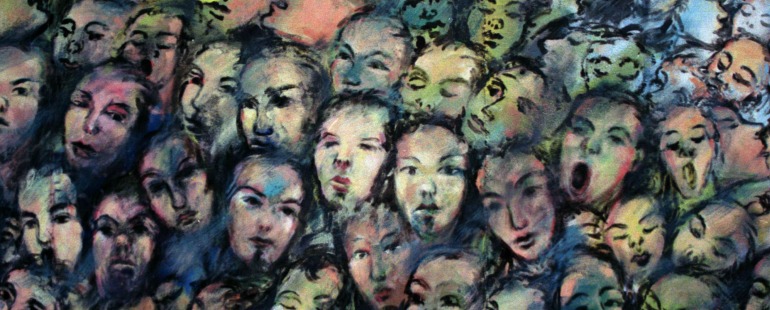The Poetics of Madness: Reading and Writing Mental Illness

I’m the girl who is lost in space, the girl who is disappearing always, forever fading away and receding farther and farther into the background. Just like the Cheshire cat, someday I will suddenly leave, but the artificial warmth of my smile, that phony, clownish curve, the kind you see on miserably sad people and villains in Disney movies, will remain behind as an ironic remnant.
—Elizabeth Wurtzel, Prozac Nation
In a sense, madness (to use an archaic but attractive term) is a problem of narrative. To put it plainly: mental illness makes it difficult to know just what the heck is going on, or to what extent one’s perceptions of events can be trusted. The mania of bipolar disorder divorces extravagant action from its consequences; conversely, the sympathetic surge of anxiety magnifies potential consequences all out of proportion with their actions. Depression pulverizes the notion of action altogether. Each, in its own way, dismantles the usual relationship between cause and effect that makes legible our experience of the world, that enables us to tell ourselves stories about our lives that give them shape and meaning.
Writing about mental illness is its own separate, but related problem. How do you write about a time in your life you did not experience in your right mind? How do you drag unreason into the realm of reason: of grammar, order, morality?
One solution is to innovate, to stretch the bounds of conventional narrative to accommodate the all-over-ness of the unwell brain. The one-to-one structure of traditional storytelling must go, to be replaced by poetics of madness: the lyrical fragments of Susanna Kaysen’s Girl, Interrupted; the manic streams of Andy Behrman’s Electroboy; even the glum, blunt declarations of Sylvia Plath’s autobiographical novel, The Bell Jar. Here the stakes of syntax and diction are raised above mere style—or rather, style and substance converge indistinguishably. The mood of the language must convey the mood of the sufferer. This is not to say, of course, that every memoir of depression need sound the same, but rather that good ones encode the taste and feel of melancholy in their DNA.
It’s no coincidence that the genre has long been dominated by women, who have always pioneered new discursive forms to convey subjectivities unexplored or deemed trivial by prevailing literary tradition. In writing these “private” states—the home, the family, or the mind itself—women have taken pains to balance formal innovation against fidelity to recognizable touchstones of storytelling. Think of the novels of Charlotte Brontë, which layer poetic descriptions of powerful moods, passions and fancies, onto (broadly) familiar tropes of 19th century realism.
The ancient dialogue between reason and the senses is almost always more interestingly and passionately resolved in favor of the senses.
– Kay Redfield Jamison, An Unquiet Mind
But issues of representation grow thornier where madness is concerned. Even mimetic fealty to events-as-they-happened betrays the essential nature of mental illness. Consider how, for instance, memoir-writing offers a refutation to a defining attribute of depression: the belief, no, surety, that the despair will persist, without respite or end, unto eternity. If you have written a memoir, then the despair has abated, at least enough for you to access the great energies required for creative production. In this the memoir of depression is a balm, for it offers hope and evidence of relief—but it is also a lie, literally unable to communicate the true hopelessness which would have precluded its writing. By its nature, the organization of experience into language betrays the nonlinear, multivalent nature of consciousness, but memoirs of madness elevate this betrayal to an art form. There is, of course, no alternative, other than silence. It is a betrayal worth committing.
In the classic memoir of depression Darkness Visible, author William Styron recalls the sensation, in deep depression, of occupying a second, dispassionate self that observes the depressive’s agony from a distance, unable to help, but interested in the proceedings nonetheless. Perhaps it is the impressions of this ghost self that memoirists try to capture once the fog of war has lifted: the tiny spark of warmth inside, biding its time, waiting to grow into a blaze within which meaning, even beauty, can be forged.
There is never a sudden revelation, a complete and tidy explanation for why it happened, or why it ends, or why or who you are. You want one and I want one, but there isn’t one. It comes in bits and pieces, and you stitch them together wherever they fit, and when you are done you hold yourself up, and still there are holes and you are a rag doll, invented, imperfect. And yet you are all that you have, so you must be enough.
– Marya Hornbacher, Wasted
And yet, even once the time is ripe for this kind of meaning-making, even once you find the words to tell the story, the project is attended by niggling complications. Considering how to relate an episode, or episodes, or decade of mental illness necessarily animates questions about the stability of identity over time, the continuity of past into present, that nestle snugly at the heart of all memoir. Am I still who I once was? Is the madness dissipated, or has it left some remnant within me, that will always keep me from seeing it clearly? What measure of falseness is it to tie a knot in the thread of experience and snip the end, as though telling a story ends the story, as though any story has an ending? As though madness does not stretch its tendrils into every corner of our lives; as though it remains the purview only of those who abjure its advances; as though the fence between sane and crazy were structurally sound.
Was I ever crazy? Maybe. Or maybe life is . . .
– Susanna Kaysen, Girl, Interrupted
Image: “Berlin Wall” at the East Side Gallery, Berlin


